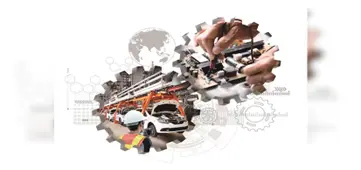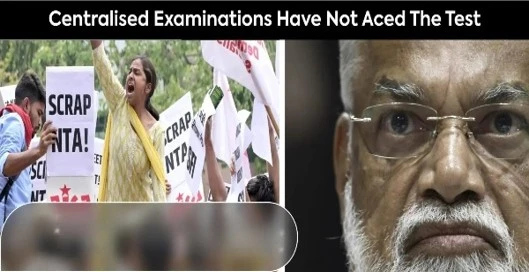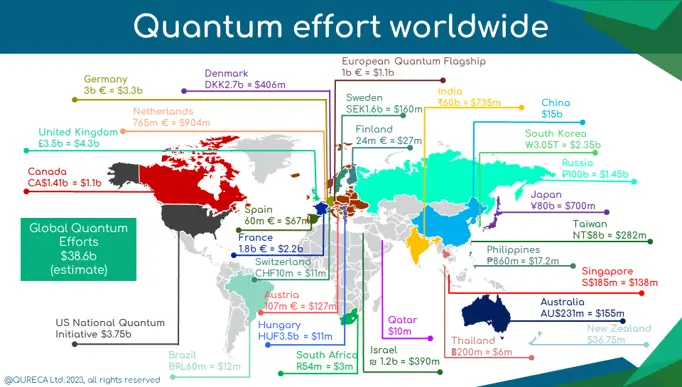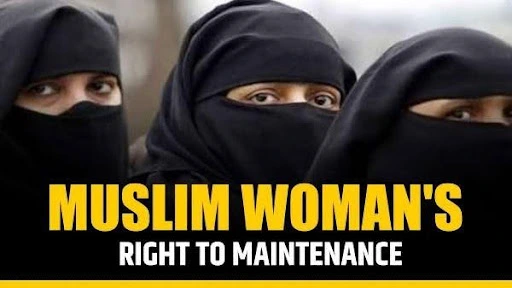Saturday, 20th July 2024
Intergenerational Equity as Tax Devolution Criterion
Why in the news?
- The allocation of Union tax revenue to States is a perennial topic among policymakers and economists, with central focus on the factors influencing the horizontal distribution of States’ shares in Union tax revenue.
- Currently, the emphasis on intragenerational equity, aimed at redistributing tax revenue among States, often results in intergenerational inequity within States.
- Therefore, it is imperative to integrate intergenerational equity into India's horizontal distribution formula for tax devolution.

Principles of Intergenerational Fiscal Equity:
- Equal Opportunities and Outcomes
- Each generation should have access to comparable opportunities and should not be disadvantaged by the fiscal policies of previous generations.
- This includes access to high-quality public services such as education, healthcare, and infrastructure.
- Sustainable Public Finance
- Governments should manage finances to ensure long-term sustainability.
- Avoid excessive borrowing that future taxpayers will have to repay, thereby preventing the accumulation of unsustainable public debt.
Mechanisms to Achieve Intergenerational Fiscal Equity:
- Taxation
- Tax revenues should be adequate to cover current public expenditures.
- This ensures that the present generation finances the services it receives, maintaining a balance between revenues and expenditures.
- Borrowing
- Borrowing should be utilised judiciously, primarily for funding large capital projects that benefit multiple generations.
- Excessive borrowing for recurrent expenditures shifts the financial burden to future generations, resulting in higher taxes or reduced public services in the future.
- Savings and Investments
- Establish sovereign wealth funds or other savings mechanisms to accumulate resources during periods of economic surplus.
- These funds can finance public expenditures during economic downturns or invest in long-term projects that benefit future generations.
Case Study: High-Income vs. Low-Income States
- High-Income States
- States: Tamil Nadu, Kerala, Karnataka, Maharashtra, Gujarat, Haryana.
- Economy: Strong, generating substantial tax revenues.
- Revenue Financing: Up to 59.3% independently.
- Union Transfers: Receive relatively low transfers, necessitating expenditure cuts or borrowing, leading to higher fiscal deficits.
- Low-Income States
- States: Bihar, Uttar Pradesh, Madhya Pradesh, Rajasthan, Odisha, Jharkhand.
- Economy: Struggle to generate sufficient own tax revenues.
- Revenue Financing: Only 35.9% independently.
- Union Transfers: Heavily reliant, financing about 57.7% of expenditures, enabling higher levels of public spending relative to their revenues.
Fiscal Indicators and Equity:
- Population and Area
- Reflect the demand for public services.
- States with larger populations and areas typically require more resources, justifying higher financial transfers.
- Per Capita Income
- Used to assess the fiscal capacity of States.
- Lower per capita income States receive more transfers to help them match the service levels of higher-income States.
- Tax Effort and Fiscal Discipline
- Efficiency indicators such as tax effort and fiscal discipline influence the distribution formula.
- States demonstrating higher tax collection efficiency and prudent fiscal management are rewarded with additional transfers, incentivizing better fiscal practices.
Issues with Intragenerational Equity:
- Disparity in Revenue Financing
- Low-income States: Bihar, Uttar Pradesh, Madhya Pradesh, Rajasthan, Odisha, and Jharkhand finance a smaller portion of their revenue expenditure with their own tax revenue and receive larger amounts of Union financial transfers.
- High-income States: Tamil Nadu, Kerala, Karnataka, Maharashtra, Gujarat, and Haryana finance a substantial portion of their revenue expenditure with their own tax revenue but receive fewer Union financial transfers.
- Tax Revenue Contribution
- High-income States: Own tax revenue (including GST, VAT, Excise, Stamp Duty, and Motor Vehicle Tax) finances up to 59.3% of their revenue expenditure.
- Low-income States: Own tax revenue finances only 35.9% of their revenue expenditure.
- Revenue Expenditure to GSDP Ratio
- High-income States: The Revenue Expenditure to GSDP ratio is 10.9%.
- Low-income States: The Revenue Expenditure to GSDP ratio is 18.3%.
- Union Financial Transfers
- Low-income States: Nearly 57.7% of revenue expenditure is financed by Union financial transfers.
- High-income States: Only 27.6% of revenue expenditure is financed by Union financial transfers.
- Fiscal Deficits
- High-income States: Had to incur a deficit of 13.1% of revenue expenditure.
- Low-income States: Ended up with a deficit of only 6.4% of revenue expenditure.
Suggestions to Strengthen Intergenerational Fiscal Equity:
- Reforming the Distribution Formula
- Incorporate More Fiscal Variables: The Finance Commission should include additional fiscal variables in the tax devolution criteria.
- Incentivize Fiscal Improvement: This inclusion would motivate States to enhance their tax efforts and expenditure efficiency, fostering sustainable fiscal practices.
- Enhancing Fiscal Discipline:
- Emphasise Responsible Borrowing: There should be a greater focus on fiscal discipline and responsible borrowing practices.
- Adherence to FRBM Limits: States should be encouraged to adhere to their Fiscal Responsibility and Budget Management (FRBM) limits and implement policies promoting long-term fiscal health.
- Promoting Balanced Development:
- Reduce Economic Disparities: Policies aimed at narrowing economic disparities between States can lead to more equitable fiscal outcomes.
- Invest in Infrastructure and Services: Investments in infrastructure, education, and healthcare in low-income States can improve their economic prospects and decrease their dependence on Union transfers.
Conclusion
Intergenerational fiscal equity is crucial for ensuring the fair distribution of economic opportunities and outcomes across generations. IBy reforming the distribution formula and encouraging responsible fiscal practices, policymakers can ensure that current fiscal decisions do not place undue burdens on future generations, promoting a more sustainable and equitable fiscal environment.
|
UPSC Civil Services examination PYQ Prelims: Q:1 With reference to the Finance Commission of India, which of the following statements is correct? (2011)
Answer: D
Q:2 Consider the following: (2023)
For the horizontal tax devolution, the Fifteenth Finance Commission used how many of the above as criteria other than population area and income distance?
Ans: (b)
Mains: Q:1 How have the recommendations of the 14th Finance Commission of India enabled the States to improve their fiscal position? (2021) Q:2 How is the Finance Commission of India constituted? What do you know about the terms of reference of the recently constituted Finance Commission? Discuss. (2018) Q:3 Q. Discuss the recommendations of the 13th Finance Commission which have been a departure from the previous commissions for strengthening the local government finances. (2013) |
Source: TH
Call for ruthless action against drugs syndicate
Why in the news?
- While chairing the 7th apex level meeting of the Narco-Coordination Centre (NCORD), Union Home Minister Amit Shah called for ruthless action against drug smuggling syndicates.
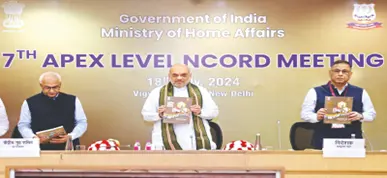
- The Minister launched a toll-free helpline called MANAS (Madak Padarth Nishedh Asuchna Kendra) with the number 1933.
- Along with this, a web portal and a mobile app were introduced to allow citizens to connect with the Narcotics Control Bureau (NCB) 24/7.
- People can use these platforms to share anonymous information about drug dealing and trafficking or to seek advice on issues like drug abuse, quitting drugs, and rehabilitation.
Narcotics Control Bureau (NCB):
- About: NCB is the apex drug law enforcement and intelligence agency of India, established in 1986 under the Narcotic Drugs and Psychotropic Substances Act (NDPS Act), 1985.
- Responsibilities: The NCB is responsible for combating drug trafficking and the abuse of illegal substances.
- Nodal Ministry: Ministry of Home Affairs, Government of India.
Narco-Coordination Centre (NCORD):
- About:
- The NCORD mechanism was formed in 2016 for better coordination between states and the Ministry of Home Affairs.
- It was further strengthened through a four-tier system in 2019.
- Aim:
- NCORD enhances coordination among various central and state agencies involved in combating drug trafficking and abuse.
- It facilitates better communication, cooperation, and intelligence sharing among law enforcement and drug control agencies.
- Structure:
- Apex Level NCORD Committee, headed by Union Home Secretary.
- Executive Level NCORD Committee, headed by Special Secretary, Ministry of Home Affairs.
- State Level NCORD Committees, headed by Chief Secretaries.
- District Level NCORD Committees, headed by District Magistrates.
Fight Against Drug Menace – India’s Regulatory Framework:
- Article 47 of the Indian Constitution:
- The National Policy on Narcotic Drugs and Psychotropic Substances is based on the Directive Principles contained in Article 47 of the Indian Constitution.
- The Article directs the State to endeavour to bring about prohibition of the consumption, except for medicinal purposes, of intoxicating drugs injurious to health.
- Signatory to International Conventions: India is a signatory to:
- The Single Convention on Narcotic Drugs 1961, as amended by the 1972 Protocol.
- The Conventions on Psychotropic Substances, 1971.
- The United Nations Convention against Illicit Traffic in Narcotic Drugs and Psychotropic Substances, 1988.
- Existing Laws: The broad legislative policy is contained in the three Central Acts:
- Drugs and Cosmetics Act, 1940.
- The Narcotic Drugs and Psychotropic Substances Act, 1985.
- The Prevention of Illicit Traffic in Narcotic Drugs and Psychotropic Substances Act, 1988.
- Institutions Involved:
- The Narcotics Control Bureau (NCB) was created in 1986 as a nodal agency to fight against this menace.
- The Ministry of Health and Family Welfare (MoHFW) and the Ministry of Social Justice and Empowerment (MSJE) are involved with alcohol and drug demand reduction policies and drug de-addiction programmes.
- To prevent misuse of dual-use drugs, a permanent inter-ministerial committee has been formed with the Ministry of Health and Family Welfare and the Ministry of Chemicals.
- Technological Intervention:
- The NCORD portal has been launched as an effective mechanism for information exchange between various institutions/agencies.
- A toll-free helpline called MANAS (Madak Padarth Nishedh Asuchna Kendra) with the number 1933 has been launched.
- Other Measures:
- The government aims to achieve a drug-free India by 2047 through a three-point strategy: strengthening institutional structure, coordination among all narco agencies, and extensive public awareness campaigns.
- As part of this strategy, a number of steps have been taken, including:
- Establishment of a dedicated Anti-Narcotics Task Force (ANTF) in each state/UT.
- High priority to drug disposal drives.
- Launch of the NIDAAN Portal for Narco offenders.
- Creation of canine squads for drug detection.
- Strengthening forensic capabilities.
- Establishment of Special NDPS Courts and Fast Track Courts.
- Nasha Mukt Bharat Abhiyan (NMBA) for generating awareness against drug abuse.
Key Highlights of the Speech Made by the Minister:
- Major Challenges Posed by Synthetic Drugs:
- The business of synthetic drugs is increasingly linked with terrorism, and drug money has emerged as a serious threat to national security.
- The drug trade also strengthens other channels of economic transactions meant to weaken the economy.
- Many organisations involved in the drug trade are also engaged in illegal hawala dealings and tax evasion.
- Maritime Routes for Drug Smuggling:
- Maritime routes are being used for smuggling drugs, threatening India's maritime security.
- Shift from "Need to Know" to "Duty to Share" Approach:
- The Minister emphasised that agencies should shift from a "Need to Know" policy to a "Duty to Share" approach.
- He stressed the need for a strict approach to cutting off drug supply, a strategic approach to reducing demand, and a compassionate approach to minimising harm.
- Although these aspects are different, all must be addressed to achieve success in combating drug issues.
- Drug Seizure Statistics:
- The Minister stated that from 2004 to 2023, 1.52 lakh kg of drugs worth ₹5,933 crore were seized.
- In the 10 years from 2014 to 2024, this quantity increased to 5.43 lakh kg, worth more than ₹22,000 crore.
|
UPSC Civil Services Examination, Previous Year Questions (PYQs) Mains Q:1 India’s proximity to the two of the world’s biggest illicit opium-growing states has enhanced her internal security concerns. Explain the linkages between drug trafficking and other illicit activities such as gunrunning, money laundering and human trafficking. What counter-measures should be taken to prevent the same? (2018) Q:2 In one of the districts of a frontier state, narcotics menace has been rampant. This has resulted in money laundering, mushrooming of poppy farming, arms smuggling and near stalling of education. The system is on the verge of collapse. The situation has been further worsened by unconfirmed reports that local politicians as well assume senior police officers are providing surreptitious patronage to the drug mafia. At that point of time a woman police officer, known for her skills in handling such situations is appointed as Superintendent of Police to bring the situation to normalcy. If you are the same police officer, identify the various dimensions of the crisis. Based on your understanding, suggest measures to deal with the crisis. (2019) |
Source: TH
Assam's Foreigners Tribunal Function
Why in the news?
- On July 5, the Assam government directed the Border wing of the State’s police to not forward cases of non-Muslims who entered India illegally before 2014 to the Foreigners Tribunals (FTs).
- This directive aligns with the Citizenship (Amendment) Act of 2019, which provides a citizenship application window for non-Muslims — Hindus, Sikhs, Christians, Parsis, Jains, and Buddhists — who allegedly fled persecution in Afghanistan, Bangladesh, and Pakistan.
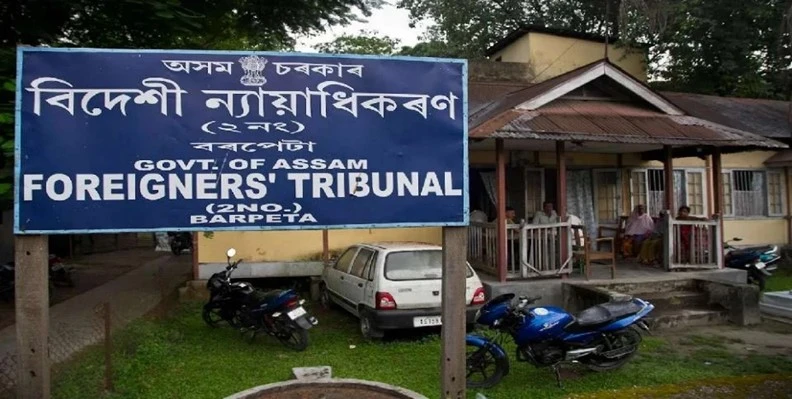
About Foreign Tribunal:
- Objective:
- Foreign Tribunals (FTs) are quasi-judicial bodies established under the Foreigners (Tribunals) Order of 1964, which was issued under Section 3 of the Foreigners’ Act of 1946.
- These tribunals allow local authorities in a state to refer individuals suspected of being foreigners for further examination.
- Exclusivity:
- Currently, FTs are exclusive to Assam, while other states handle cases of "illegal immigrants" under the Foreigners’ Act.
- Composition:
- Each FT is led by a member who is a judge, advocate, or civil servant with judicial experience.
- In 2021, the Ministry of Home Affairs informed Parliament that Assam has 300 FTs.
- However, the State’s Home and Political Department website indicates that only 100 FTs are currently operational.
Powers of Foreign Tribunal:
- Under the 1964 order, FTs possess similar powers to civil courts.
- They can summon people, enforce attendance, examine individuals under oath, and request documents.
- When a person is suspected of being a foreigner, the tribunal must serve a notice in English or the state's official language within 10 days of receiving the case.
- The individual then has 10 days to respond and another 10 days to present evidence supporting their claim of citizenship.
- The FT must resolve the case within 60 days.
- If the person cannot prove their citizenship, the tribunal can send them to a detention centre, now called a transit camp, for eventual deportation.
Role of Assam Police Border Organisation:
- Formation and Evolution:
- The Assam Police Border Organisation was initially formed in 1962 as part of the State police’s Special Branch under the Prevention of Infiltration of Pakistani (PIP) scheme.
- It became an independent wing in 1974 and is now led by the Special Director General of Police (Border).
- Following Bangladesh's liberation war, the PIP scheme was renamed the Prevention of Infiltration of Foreigners (PIF) scheme.
- Personnel:
- The Central government has sanctioned 3,153 of the 4,037 personnel posts in this wing under the PIF scheme, with the remaining 884 posts sanctioned by the Assam government.
- Responsibilities:
- Detecting and deporting illegal foreigners.
- Patrolling the India-Bangladesh border alongside the Border Security Force.
- Maintaining a secondary line of defence to prevent illegal entry.
- Monitoring people living in riverine and sandbar areas.
- Referring individuals with questionable citizenship to FTs to determine their nationality based on documentation.
- The Election Commission of India can also refer cases of 'D' (doubtful) voters to an FT.
- People excluded from the National Register of Citizens (NRC) draft, released in August 2019, can appeal to FTs to prove their citizenship.
- Approximately 19.06 lakh out of 3.3 crore applicants were excluded from the NRC, and the process is currently on hold.
About the Recent Controversy:
- Supreme Court Ruling:
- On July 11, 2024, the Supreme Court overturned a Foreign Tribunal decision that had declared Rahim Ali, a now-deceased farmer, a foreigner 12 years ago.
- The court termed this decision a "grave miscarriage of justice" and emphasised that the Foreigners’ Act does not authorise authorities to randomly select people and demand they prove their citizenship.
- Industry-like Scenario:
- In September 2018, an FT member in Morigaon, central Assam, remarked that cases involving foreigners had become like an industry, with many people trying to profit from the situation.
- The member also pointed out that notices were often placed on trees or electric poles, leaving the accused unaware of the cases against them.
|
UPSC Civil Services Examination, Previous Year Question (PYQ) Prelims: Q:1 Consider the following statements: (2009)
Which of the statements given above is/are correct?
Ans: (b)
Mains: Q:1 “The Central Administrative Tribunal which was established for redressal of grievances and complaints by or against central government employees, nowadays is exercising its powers as an independent judicial authority.” Explain. (2019) |
Source: TH
Green Revolution in Maize
Why in the news?
- Recently, India's maize industry has undergone a remarkable transformation, evolving from a basic feed crop to a crucial component in the fuel and industrial sectors.
- This shift is indicative of a broader green revolution, echoing the historic advances made in wheat and rice but with a modern twist driven largely by private-sector innovations.
What is the Current State of Maize Production in India?
- Tripling Production:
- Since 1999-2000, India's maize production has more than tripled, increasing from 11.5 million tonnes to over 35 million tonnes annually.
- Average per-hectare yields have also risen from 1.8 to 3.3 tonnes.
- As per APEDA, India is the fifth largest maize producer, accounting for 2.59% of global production in 2020.
- Maize is the third most important cereal crop in India after rice and wheat, accounting for around 10% of total food grain production in the country.
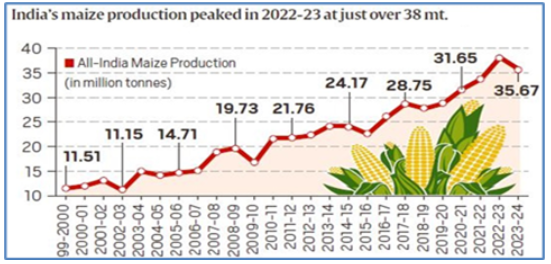
- Major States:
- Karnataka, Madhya Pradesh, Bihar, Tamil Nadu, Telangana, Maharashtra, and Andhra Pradesh are the primary maize-growing states.
- Year-Round Cultivation:
- Maize is grown throughout the year, predominantly as a Kharif crop, with 85% of the maize cultivation area during this season.
- Export Volume:
- India exported 3,453,680.58 MT of maize worth Rs. 8,987.13 crores in 2022-23.
- Major export destinations include Bangladesh, Vietnam, Nepal, Malaysia, and Sri Lanka.
- Major Uses:
- Approximately 60% of maize is used as feed for poultry and livestock, while only about 20% is directly consumed by humans.
- Maize is a primary energy source in livestock feed, with 55-65% of broiler feed and 15-20% of cattle feed comprising maize.
- Maize grains, containing 68-72% starch, are used in industries such as textiles, paper, and pharmaceuticals.
- Recent developments have shifted focus to using maize for ethanol production, particularly as a substitute for rice in ethanol blending due to food security concerns.
- During the crushing season, distilleries run on sugarcane molasses and juice/syrup, while in the off-season they use grains, with a recent shift towards maize.
Green Revolution:
- Leadership and Achievements
- Norman Borlaug: Spearheaded the Green Revolution in the 1960s, developing High Yielding Varieties (HYVs) of wheat. His contributions earned him the Nobel Peace Prize in 1970 for his role in alleviating global hunger.
- Role in India
- M.S. Swaminathan: Played a pivotal role in advancing the Green Revolution in India, significantly boosting the production of wheat and rice through high-yielding varieties.
- Transformation: Between 1967-68 and 1977-78, the Green Revolution transformed India from a food-deficient nation to a leading agricultural power, enhancing food security and reducing reliance on imports.
How does Maize's Green Revolution Compare to Wheat and Rice?
- Self-Pollinating vs. Cross-Pollinating:
- Unlike self-pollinating wheat and rice, maize's cross-pollinating nature makes hybrid breeding commercially viable.
- The Green Revolution in wheat and rice was driven by farmers cultivating high-yielding varieties, being self-pollinating plants that are not amenable to hybridization.
- The Green Revolution in maize has been, and continues to be, a private sector-led one. Private-sector hybrids dominate over 80% of maize cultivation, with high yields limited to the first generation.
- Farmers cannot harvest the same yields if they save the grains from these yields and reuse them as seeds (self-termination nature of seeds).
- Innovations in Maize Cultivation:
- The Indian Agricultural Research Institute (IARI) has bred India’s first “waxy” maize hybrid (AQWH-4) with high amylopectin starch content, making it better suited for ethanol production.
- Normal maize starch has 30% amylose and 70% amylopectin, while IARI’s waxy maize hybrid has 93.9% amylopectin.
- Amylose starch makes the grain hard, while amylopectin makes it soft, affecting starch recovery and fermentation rates.
- Softness aids in better grain grinding for flour production. Granules with higher amylopectin are more easily broken down into glucose units, which are then fermented into ethanol using yeast.
- Normal maize grains have 68-72% starch, but only 58-62% is recoverable. The new Pusa Waxy Maize Hybrid-1 has 71-72% starch with 68-70% recovery.
- This hybrid offers an average yield of 7.3 tonnes per hectare and has the potential to reach 8.8 tonnes.
- Private Sector's Role:
- The International Maize and Wheat Improvement Center (CIMMYT) has established a maize doubled haploid (DH) facility in Kunigal (Karnataka), producing high-yielding, genetically pure inbred lines.
- This facility speeds up the development of maize hybrids and enhances breeding efficiency.
- In the conventional process, inbred lines are formed by continuous self-pollination for 6-8 generations. DH technology enables the production of completely uniform lines after just two cropping cycles.
- In 2022, the Kunigal facility produced and shared 29,622 maize DH lines. The lines are high-yielding, tolerant to drought, heat, and waterlogging, nutrient-use efficient, and resistant to pests and diseases such as fall armyworm and maize lethal necrosis.
- Companies like Mahyco, Shriram Bioseed, Advanta Seeds, and others play a significant role in developing and promoting high-yield maize hybrids.
Initiatives to Promote Maize in India:
- National Food Security Mission (NFSM)
- Objective: To increase the production of rice, wheat, pulses, coarse cereals, and commercial crops by extending the area under cultivation and enhancing productivity.
- Maize Focus: Under the NFSM, special emphasis is given to promoting maize cultivation through improved seed distribution, mechanisation, pest management, and efficient irrigation practices.
- India Maize Summit
- Background: Organised in 2022, the summit brought together various stakeholders, including farmers, industry experts, policymakers, and researchers.
- Focus Areas:
- Securing a sustainable maize supply to meet the growing demand in various sectors, including food, feed, and industrial uses.
- Discussing technological advancements, market trends, and innovations in maize cultivation.
- Strategies to enhance farmer prosperity through better pricing, market access, and adoption of high-yield varieties.
- Rashtriya Krishi Vikas Yojana (RKVY)
- Objective: To incentivize states to increase public investment in agriculture and allied sectors.
- Maize Promotion: Under RKVY, states are encouraged to implement maize-specific projects focusing on:
- High-yield seed distribution.
- Capacity building and training programs for farmers.
- Adoption of modern agricultural practices and technologies.
- Development of infrastructure for storage, processing, and marketing.
|
UPSC Civil Services Examination, Previous Year Questions (PYQ) Prelims Q:1 Given below are the names of four energy crops. Which one of them can be cultivated for ethanol? (2010) (a) Jatropha (b) Maize (c) Pongamia (d) Sunflower
Ans: (b) |
Practice Questions - Current Affairs 20-07-2024
Q1. With reference to Gandhi Sagar Wildlife Sanctuary , consider the following statements :
- It will become the second sanctuary in India to house cheetahs, following Kuno National Park.
- The Betwa river divides the sanctuary into two nearly equal parts.
- The sanctuary features a savanna ecosystem with open grasslands mixed with dry deciduous trees and shrubs.
How many of the statements given above are correct?
- Only one
- Only two
- Only three
- None
Q2. Consider the following statements regarding the Direct Seeding of Rice (DSR) :
- Rice seeds are directly sown in the field rather than being grown as seedlings in a nursery and then transplanted into flooded fields.
- Direct Seeding of Rice (DSR) enables quicker planting and maturation while conserving valuable resources such as water and labor.
- This method is widely practiced in Asian countries.
Which of the statements given above is/are correct?
- 1 and 2 only
- 2 only
- 3 only
- 1, 2 and 3
Q3. Consider the following statements:
- Marsupials nurture their newborns in an external pouch located on the front or underside of their bodies.
- Placentals are mammals that give birth to live young.
- The majority of marsupials are found in Australia and South America.
How many of the statements given above are correct?
- Only one
- Only two
- All three
- None
Q4. Consider the following statements regarding Sustainable Development Report 2024:
- It assesses the annual progress on Sustainable Development Goals (SDGs) by the 193 UN Member States.
- It is published by the United Nations Environment Programme.
Which of the statements given above is/are correct?
- Only 1
- Only 2
- Both
- None
Q5. Consider the following statements regarding Sustainable Development Report 2024:
- It assesses the annual progress on Sustainable Development Goals (SDGs) by the 193 UN Member States.
- It is published by the United Nations Environment Programme.
Which of the statements given above is/are correct?
- Only 1
- Only 2
- Both
- None
Q6. Consider the following statements regarding Green Ammonia :
- Green ammonia production refers to creating ammonia through a completely renewable and carbon-free process.
- It involves using hydrogen derived from water electrolysis and nitrogen extracted from the air.
- Ammonia can be easily stored in bulk as a solid under modest pressures (10-15 bar) or by refrigeration to -33°C.
Which of the statements given above is/are correct?
- 1 only
- 1 and 2 only
- 2 and 3 only
- 2 only
Q7. Consider the following statements about National Disaster Response Fund (NDRF):
- It is outlined in Section 46 of the Disaster Management Act, 2005 (DM Act).
- It falls under the "Public Account" of the Government of India, classified as "reserve funds not bearing interest."
Which of the above statements is/are correct?
- Only 1
- Only 2
- Both
- None
Q8. Consider the following statements about National Disaster Response Fund (NDRF):
- It is outlined in Section 46 of the Disaster Management Act, 2005 (DM Act).
- It falls under the "Public Account" of the Government of India, classified as "reserve funds not bearing interest."
Which of the above statements is/are correct?
- Only 1
- Only 2
- Both
- None
Q9. Consider the following statements about Araku Coffee:
- It is cultivated in the Araku Valley, located in the Alluri SitaRam Raju district of Andhra Pradesh.
- It has been granted a Geographical Indication (GI) tag, alongside others such as Coorg Arabica, Wayanad Robusta, Chikmagalur Arabica, and Baba Budangiri Arabica.
Which of the above statements is/are correct?
- Only 1
- Only 2
- Both
- None
Q10. Consider the following statements regarding the Hindu Kush Himalayan (HKH) region:
- It spans from Afghanistan in the west to Myanmar in the east, encompassing countries such as India.
- This region serves as the origin for river systems including the Indus, Ganges, and Brahmaputra.
Which of the statements given above is/are not correct?
- Only 1
- Only 2
- Both
- None
Q11. Consider the following statements regarding the International Union for Conservation of Nature:
- The IUCN is a membership union consisting solely of government organizations.
- The IUCN Red List of Threatened Species is the most comprehensive global inventory of the conservation status of plant and animal species.
Which of the statements given above is/are correct?
- Only 1
- Only 2
- Both 1 and 2
- Neither 1 nor 2
Q12. With reference to the National Disaster Management Authority (NDMA), consider the following statements:
- Under the Disaster Management Act of 2005, the Home Minister serves as the chairperson of the National Disaster Management Authority.
- This apex body formulates policies, plans, and guidelines for disaster management to ensure a timely and effective response to disasters.
Which of the statements given above is/are not correct?
- Only 1
- Only 2
- Both 1 and 2
- Neither 1 nor 2
Q13. Sympatric Speciation , recently in news in related to :
- The formation of new species from geographically isolated populations.
- The formation of new species from a small population isolated at the edge of a larger population
- The formation of new species from a continuously distributed population.
- The formation of new species within the range of the ancestral population.
Q14. Consider the following statements about the Nile River:
- It originates south of the equator in Burundi, Africa.
- It flows through Egypt and 10 other African countries before emptying into the Mediterranean Sea.
- The Nile comprises of two main tributaries, the Blue Nile and the White Nile.
How many of the statements given above are correct?
- Only one
- Only two
- All three
- None
Q15. With reference to National Tiger Conservation Authority (NTCA), consider the following statements :
- Under the Ministry of Environment, Forest, and Climate Change (MoEFCC), it provides statutory authority to Project Tiger.
- It was established under the enabling provisions of the Wildlife (Protection) Act, 1972.
Which of the statements given above is/are correct?
- Only 1
- Only 2
- Both 1 and 2
- Neither 1 nor 2
Q16. Consider the following statements about Asiatic Wild Dogs (Dhole):
- In India, they are exclusively found in the Western Ghats.
- It is listed as Critically Endangered on the IUCN Red List.
- Dholes are highly social animals that often hunt in packs.
How many of the statements given above are correct?
- Only One
- Only Two
- All Three
- None
Q17. Consider the following statements regarding Geoengineering:
- It is a method specifically created to address the impacts of climate change.
- This is typically achieved by either extracting carbon dioxide (CO2) from the atmosphere or reducing the amount of sunlight reaching the Earth's surface.
- Stratospheric Aerosol Injection (SAI) is an example of such geoengineering techniques.
Which of the above statements is/are correct?
- Only one
- Only two
- All Three
- None
Q18. Consider the following statements regarding Geoengineering:
- It is a method specifically created to address the impacts of climate change.
- This is typically achieved by either extracting carbon dioxide (CO2) from the atmosphere or reducing the amount of sunlight reaching the Earth's surface.
- Stratospheric Aerosol Injection (SAI) is an example of such geoengineering techniques.
Which of the above statements is/are correct?
- Only one
- Only two
- All Three
- None
Q19. Consider the following statements regarding Geoengineering:
- It is a method specifically created to address the impacts of climate change.
- This is typically achieved by either extracting carbon dioxide (CO2) from the atmosphere or reducing the amount of sunlight reaching the Earth's surface.
- Stratospheric Aerosol Injection (SAI) is an example of such geoengineering techniques.
Which of the above statements is/are correct?
- Only one
- Only two
- All Three
- None
Q20. Consider the following statements regarding Geoengineering:
- It is a method specifically created to address the impacts of climate change.
- This is typically achieved by either extracting carbon dioxide (CO2) from the atmosphere or reducing the amount of sunlight reaching the Earth's surface.
- Stratospheric Aerosol Injection (SAI) is an example of such geoengineering techniques.
Which of the above statements is/are correct?
- Only one
- Only two
- All Three
- None
Share the article
Edukemy’s Current Affairs Quiz is published with multiple choice questions for UPSC exams
MCQ
Get Latest Updates on Offers, Event dates, and free Mentorship sessions.

Get in touch with our Expert Academic Counsellors 👋
FAQs
UPSC Daily Current Affairs focuses on learning current events on a daily basis. An aspirant needs to study regular and updated information about current events, news, and relevant topics that are important for UPSC aspirants. It covers national and international affairs, government policies, socio-economic issues, science and technology advancements, and more.
UPSC Daily Current Affairs provides aspirants with a concise and comprehensive overview of the latest happenings and developments across various fields. It helps aspirants stay updated with current affairs and provides them with valuable insights and analysis, which are essential for answering questions in the UPSC examinations. It enhances their knowledge, analytical skills, and ability to connect current affairs with the UPSC syllabus.
UPSC Daily Current Affairs covers a wide range of topics, including politics, economics, science and technology, environment, social issues, governance, international relations, and more. It offers news summaries, in-depth analyses, editorials, opinion pieces, and relevant study materials. It also provides practice questions and quizzes to help aspirants test their understanding of current affairs.
Edukemy's UPSC Daily Current Affairs can be accessed through:
- UPSC Daily Current Affairs can be accessed through Current Affairs tab at the top of the Main Page of Edukemy.
- Edukemy Mobile app: The Daily Current Affairs can also be access through Edukemy Mobile App.
- Social media: Follow Edukemy’s official social media accounts or pages that provide UPSC Daily Current Affairs updates, including Facebook, Twitter, or Telegram channels.

